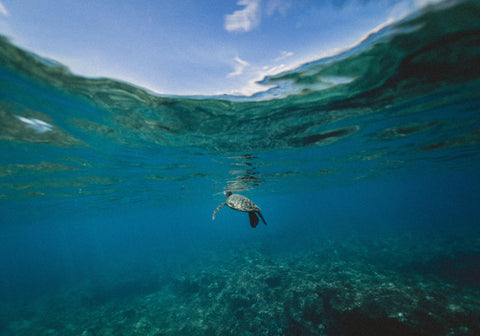The body of water is a vast place, and not all of it looks the aforementioned – with varying temperatures, lite, and marine life, scientists have classified the ocean into five chief zones: the sunlight zone, the twilight zone, the midnight zone, the abyss, and even further down, the trenches.
Keep reading for an in-depth look at what these ocean zones are like, and what kind of creatures you lot'd meet there!
ane. The Sunlight Zone (Euphotic Zone)

The sunlight zone gets its name because this is where most of the visible light is. This zone begins at the surface and ends near 660 feet downwards, and with all that low-cal comes enough of oestrus, which means that a huge variety of marine life make the sunlight zone their home.
The marine life that alive in the sunlight zone have no shortage of small fish or phytoplankton to feed off (since they call this zone abode likewise). Some of the most common marine species hither include sharks, stingrays, tuna, jellyfish, and fifty-fifty sea turtles!
While the warm water and sunlight do make for platonic living conditions, there aren't a lot of places to hide (due to all the light) – which works in favor of sharks and bounding main turtles, but is deadly to their casualty.
two. The Twilight Zone (Dysphotic Zone)
In one case you become past the 660 foot mark, y'all'll enter the twilight zone, which extends down to 3,280 feet. Hither, while there tin can be some faint light towards the showtime, photosynthesis can no longer occur, so no plants are able to survive in this zone.
As water pressure increases and temperature decreases, the marine life that thrive in the twilight zone take to be able to withstand its tough conditions. These animals may take thinner bodies to hide from potential predators, or darker bodies to better cover-up themselves into the night surroundings. Octopus, squid, and hatchet fish make this zone their dwelling, and some whales even visit the twilight zone to feed.
You'll fifty-fifty begin to observe bioluminescence fish, which create their own light in these dark conditions!
three. The Midnight Zone (Aphotic Zone)

From iii,280 anxiety to most xiii,135 anxiety is the midnight zone, which, hence the name, doesn't accept whatsoever sunlight. Whatever light that IS produced here comes from bioluminescent fish! Water force per unit area is even greater in this zone, and depending where yous're located, it tin be equally high equally 2 tons per square inch.
But like in the twilight zone, photosynthesis does not occur here, which ways you won't run into whatever plans living down here. While the unabridged area is chosen the midnight zone, scientists have actually categorized information technology into two different sections:
- The bathyal zone: The bathyal zone is the first part of the midnight zone, and it covers just about vi,600 anxiety.
- The abyssal zone: The abyssal zone makes upward the remaining part of the midnight zone, all the way down to xiii,135 feet, and extends farther down into "the abyss." (Nosotros'll get more into this below!)
Forth with sperm whales that venture down hither to feed, the midnight zone is dwelling to certain kinds of algae, anglerfish, mussels, vampire squid, and tripod fish.
4. The Abyss (Abyssal Zone)
From xiii,135 feet to 19,700 anxiety, the Abyssal zone (aka "the abyss") contains cipher sunlight and crushing levels of water pressure. The Abyssal zone alone covers around 83% of the total area of the ocean!
Although the abyssal zone is and then vast, very few animals tin can handle the farthermost conditions. Those that can withstand the pressure are usually invertebrates, like tiny squid or handbasket stars (a species of bounding main star). Nutrient is scarce here, and many of these animals end up eating whatever they can get their easily (or fins) on.
5. The Trenches (Hadal Zone)

The Trenches covers the ocean from around 20,000 feet to the very bottom – which may be close to 36,000 anxiety. Not only is the temperature this deep, freezing or below in the trenches, but the water pressure is farthermost at viii tons per square inch in the Mariana Trench (the deepest ocean trench on earth).
These trenches are steep depressions in the deepest parts of the bounding main, which is what this zone is aptly named for. Information technology'southward also officially known as the Hadal zone, later Hades, the Greek god of the Underworld.
While the hadal zone may take pretty hostile living weather, a small percentage of marine life do make their dwelling here. This sectional lodge of deep-deep bounding main dwellers includes grenadiers, pearlfish, cusk-eels, and cutthroat eels.
Final Thoughts
With five unlike zones that brand up over 35,000 feet, the ocean is mind-blowingly immense. In fact, less than x% of the the global ocean has been mapped. We have and then much more exploring to do!
And while you may never be able to venture into the midnight zone or downward into the trenches yourself, you tin yet support marine life! Cheque out our newly released Strawberry Squid clasp , fifteen% of each sale goes right back to the Woods Pigsty Oceanic Institution!
